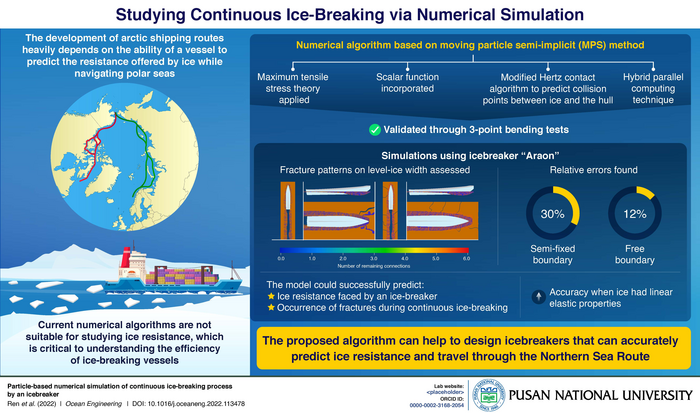Global warming has put a significant strain on resources, and hence, economic opportunities, military considerations, and trade. The development of Arctic shipping routes is necessary to compensate for these changes, and so, has garnered much interest recently. One of the fundamental requirements of a vessel navigating the polar seas is its ability to predict ice resistance. Many researchers have used numerical algorithms to study the ice-breaking capacity of icebreakers—i.e., ships capable of breaking through the ice. However, most of these algorithms cannot be used to study the continuous ice-breaking process, and no general ice fracture criterion exists for different environments.

Credit: Jong-Chun Park from Pusan National University, Korea
Global warming has put a significant strain on resources, and hence, economic opportunities, military considerations, and trade. The development of Arctic shipping routes is necessary to compensate for these changes, and so, has garnered much interest recently. One of the fundamental requirements of a vessel navigating the polar seas is its ability to predict ice resistance. Many researchers have used numerical algorithms to study the ice-breaking capacity of icebreakers—i.e., ships capable of breaking through the ice. However, most of these algorithms cannot be used to study the continuous ice-breaking process, and no general ice fracture criterion exists for different environments.
Set against this backdrop, a duo of researchers from Pusan National University (PNU), Korea, have now developed a numerical algorithm using an elastic model based on the moving particle semi-implicit (MPS) method. The study, which was led by Prof. Jong-Chun Park from PNU, was made available online on January 12, 2023, and later published in Volume 270 of Ocean Engineering on February 15, 2023. Prof. Park, explains the starting point of their study: “We assumed ice to be a linear elastic material prior to fracture, and applied the maximum tensile stress theory as the criteria for fracture.”
The MPS method is a particle method based on continuum mechanics, which is ideal for studying the continuous ice-breaking process including the development of a crack-like phenomenon. In addition, a scalar function was introduced to represent the relative position of a new ice crack with respect to the particles adjacent to it, and a search algorithm was used to predict the collision points between the ice and the hull. A hybrid parallel computing technique was introduced to manage the large-scale computations involved.
The model was tested using three-point bending tests on freshwater and model ice specimens. These revealed an increase in the accuracy of the model when the properties of the ice were close to the linear elastic properties chosen for the model. Then, simulations were performed using a model icebreaker called Araon. These simulations showed relative errors of 12% for free boundary conditions and 30% for semi-fixed boundary conditions in level-ice environments. “The model can successfully predict the ice resistance faced by an icebreaker, as well as the occurrence of fractures during continuous ice-breaking. This can be used to design icebreakers that can travel through the Northern Sea Route, where they often encounter ice. Developing this shipping route will help trade and also ensure an improved distribution of resources,” concludes Prof. Park.
We hope this algorithm can be used to build better ships for navigating the Arctic routes in the future!
***
Reference
Authors: Di Ren1, 2, Jong-Chun Park2*
Title of original paper: Particle-based numerical simulation of continuous ice-breaking process by an icebreaker
Journal: Ocean Engineering
DOI: https://doi.org/10.1016/j.oceaneng.2022.113478
Affiliations:
1Department of Naval Architecture & Ocean Engineering, Pusan National University, Korea
2College of Naval Architecture & Ocean Engineering, Beibu Gulf University, China
*Corresponding author’s email: [email protected]
ORCID ID: 0000-0002-3168-2054
About Pusan National University
Pusan National University, located in Busan, South Korea, was founded in 1946, and is now the no. 1 national university of South Korea in research and educational competency. The multi-campus university also has other smaller campuses in Yangsan, Miryang, and Ami. The university prides itself on the principles of truth, freedom, and service, and has approximately 30,000 students, 1200 professors, and 750 faculty members. The university is composed of 14 colleges (schools) and one independent division, with 103 departments in all.
Website: https://www.pusan.ac.kr/eng/Main.do
About the author
Prof. Jong-Chun Park is a full Professor of Naval Architecture and Ocean Engineering at Pusan National University (PNU), South Korea. His research group has been developing Computational Fluid Dynamics (CFD) simulation technology for hydrodynamics in the field of naval architecture and ocean engineering. Before coming to PNU, he was a faculty member at the University of Tokyo (UoT), Japan, and completed postdoctoral training in the division of Marine Environment at the Port and Airport Research Institute (PARI), Japan and in Civil Engineering at Texas A&M University, USA. In 1994, Jong-Chun Park received a Ph.D. in Naval Architecture and Ocean Engineering from UoT, Japan.
Journal
Ocean Engineering
DOI
10.1016/j.oceaneng.2022.113478
Method of Research
Computational simulation/modeling
Subject of Research
Not applicable
Article Title
Particle-based numerical simulation of continuous ice-breaking process by an icebreaker
Article Publication Date
15-Feb-2023
COI Statement
The authors declare no conflict of interest




